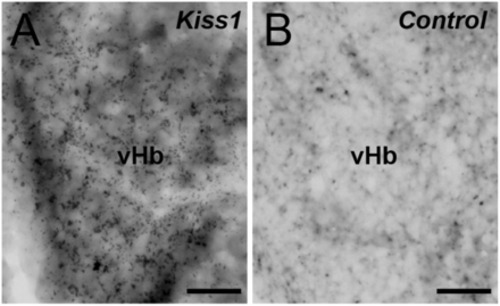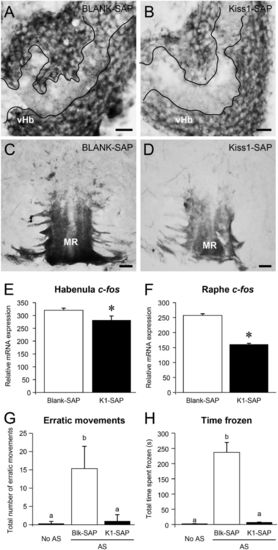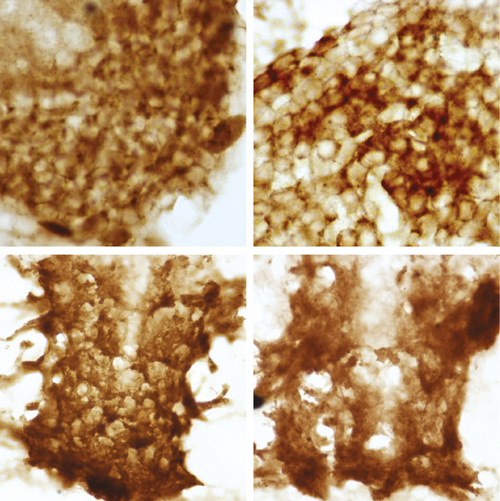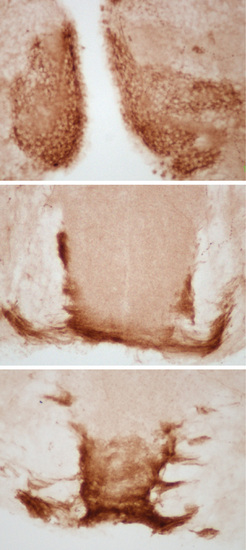- Title
-
Habenular kisspeptin modulates fear in the zebrafish
- Authors
- Ogawa, S., Nathan, F.M., Parhar, I.S.
- Source
- Full text @ Proc. Natl. Acad. Sci. USA
|
Effect of administration of Kiss1 on c-fos mRNA expression in the habenula. Effect of Kiss1 decapeptide (1011 mol per fish) (A) or water (B) on the expression of c-fos mRNA in the vHb. Expression of c-fos mRNA in the vHb is seen as black grains with the DAB substrate. (Scale bars, 20 µm.) |
|
Effect of Kiss1-SAP on Kiss1 immunoreactivity, on c-fos mRNA expression levels in the habenula and the median raphe, and on AS-evoked fear response. (A–D) Transverse sections of Kiss1 immunoreactivity in the ventral habenula (vHb; A and B) and the median raphe (MR; C and D) in the brain of zebrafish injected with Blank-SAP (A and C) or Kiss1-SAP (B and D) at 12 d after injection (103 mol per fish; intracranial administration, n = 3 per group). Kiss1 immunoreactive fibers were relatively reduced in the area of neuropil of the vHb (encircled by white lines) in Kiss1-SAP-treated fish compared with the Blank-SAP group (A and B). Kiss1 immunoreactive axons entering the MR were relatively weak, and fewer fibers were seen in the superior raphe regions in Kiss1-SAP-treated fish compared with in the Blank-SAP group (C and D). (Scale bars, 20 µm.) (E and F) Graphs showing the effect of Kiss-SAP on mRNA levels of c-fos in the habenula (E) and raphe (F) regions at 3 d after injection (n = 10 per group). (G and H) Graphs of behavioral parameters of fear response: the number of erratic movements (G) and the freezing time (H) in the zebrafish injected with Blank-SAP (open column) or Kiss1-SAP (closed column) (105 mol per fish; intracranial administration, n =10 per group) at 3 d after injection. Behavior data of control (no AS, fish treated with distilled water) are provided for comparison. Data are presented as mean ± SEM. Significant differences (P < 0.05) between groups are indicated by different letter codes; one-way ANOVA followed by post hoc Tukey’s test. |
|
Effect of Kiss1-SAP on Kiss1 immunoreactivity 3-d after injection. (A–D) Transverse sections of Kiss1 immunoreactivity in the ventral habenula (vHb; A and B) and the median raphe (MR; C and D) in the brain of zebrafish injected with Blank-SAP (A and C) or Kiss1-SAP (B and D) at 3 d after injection (103 mol per fish, intracranial administration; n = 3 per group). (Scale bars, 10 µm.) Note that there was no effect of Kiss1-SAP on Kiss1-immunoreactivity compared with in Blank-SAP treated fish at 3-d after injection, which could be due to a time course effect. Therefore, we decided to observe the effect of Kiss1-SAP at 12-d after injection (Fig. 6). |
|
Zebrafish Kiss1 immunoreactivity in the habenula and the median raphe. Immunohistochemistry using a newly generated antiserum to preprozebrafish Kiss1 showed Kiss1 immunoreactive cells in the ventral habenula (vHb; A) and immunoreactive fibers in the ventral interpeduncular nucleus (vIPN; B) and the median raphe (MR; C) through the fasciculus retroflexus (FR). No further immunoreactive fibers were seen after the MR, suggesting that the habenular Kiss1 neurons are terminated at the MR, but not in the vIPN. (Scale bars, 50 µm.) |




